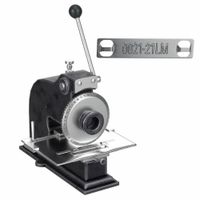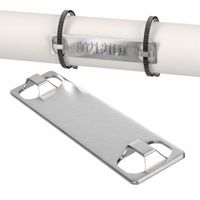Call +(254) 703 030 000 / 751 483 999 / 721 704 777
- Home
- Safety
- Signs Facility Identification Products
- Label Printers
- Label Stamping Presses Supplies
.....Read More
Frequently Asked Questions
What are label stamping presses used for?
Label stamping presses are used for the production and application of labels on various products and packaging. These machines are essential in industries such as food and beverage, pharmaceuticals, cosmetics, and consumer goods, where labeling is crucial for branding, information dissemination, and regulatory compliance.
Label stamping presses operate by applying pressure to transfer ink or foil onto a substrate, creating labels with text, graphics, or barcodes. They can handle a variety of materials, including paper, plastic, and metal foils, allowing for versatility in label design and application.
These presses are capable of producing high-quality, durable labels that can withstand environmental factors such as moisture, heat, and abrasion. They are often used for embossing, debossing, and hot foil stamping, which add aesthetic and tactile elements to labels, enhancing product appeal and differentiation.
In addition to creating labels, these presses can be integrated into production lines for automated labeling, improving efficiency and consistency. They can be configured for different label sizes, shapes, and colors, accommodating diverse product lines and packaging types.
Overall, label stamping presses are vital for ensuring that products are properly identified, branded, and compliant with industry standards, while also contributing to the visual appeal and marketability of the products.
How do label stamping presses work?
Label stamping presses work by using a combination of pressure and heat to transfer a design or text onto a substrate, such as paper, plastic, or fabric. The process begins with the creation of a metal die, which contains the desired design in reverse. This die is mounted onto the press.
The substrate to be labeled is fed into the press, either manually or automatically. The press applies pressure, and if necessary, heat, to the die, which then presses against a foil or ink ribbon placed between the die and the substrate. The heat and pressure cause the foil or ink to adhere to the substrate in the shape of the design on the die.
There are different types of label stamping presses, including hot stamping and cold stamping. Hot stamping uses heat to activate the adhesive properties of the foil, while cold stamping relies on pressure-sensitive adhesives.
The press can be adjusted for different levels of pressure and temperature, depending on the materials being used and the desired effect. Some presses are capable of multi-color stamping by using multiple dies and foils in sequence.
Label stamping presses are used in various industries for branding, decorative purposes, and information labeling. They are valued for their ability to produce high-quality, durable labels with a distinct appearance.
What materials can be used with label stamping presses?
Label stamping presses can be used with a variety of materials, including:
1. **Paper**: Commonly used for labels due to its versatility and cost-effectiveness. It can be coated or uncoated, depending on the desired finish.
2. **Cardstock**: Thicker than regular paper, cardstock is used for more durable labels, often for packaging or promotional materials.
3. **Foil**: Metallic foils are used for decorative labels, providing a shiny, reflective surface. They are often used in hot stamping processes.
4. **Vinyl**: Durable and weather-resistant, vinyl is ideal for outdoor labels or those exposed to harsh conditions.
5. **Polyester**: Known for its strength and resistance to chemicals and moisture, polyester is used for industrial and high-performance labels.
6. **Polypropylene**: A flexible and durable plastic material, polypropylene is used for labels that require a high level of durability and resistance to water and chemicals.
7. **Polyethylene**: Similar to polypropylene, polyethylene is used for flexible and durable labels, often in the food and beverage industry.
8. **Fabric**: Used for clothing labels, fabric materials like satin, cotton, or nylon can be stamped for branding or care instructions.
9. **Leather**: Used for high-end or luxury labels, leather can be stamped for a premium look and feel.
10. **Metal**: Thin metal sheets can be stamped for durable and long-lasting labels, often used in industrial settings.
11. **Laminates**: Used to add a protective layer to labels, laminates can be stamped to enhance durability and appearance.
These materials can be processed using various stamping techniques, such as hot stamping, embossing, or debossing, to achieve the desired label design and functionality.
What are the benefits of using stamped metal labels?
Stamped metal labels offer several benefits:
1. **Durability**: Made from materials like aluminum, stainless steel, or brass, these labels withstand harsh environments, including extreme temperatures, moisture, and chemicals, ensuring longevity.
2. **Legibility**: The stamping process creates clear, permanent impressions that remain readable over time, even in challenging conditions.
3. **Customization**: They can be tailored to specific needs, including various shapes, sizes, and designs, allowing for unique branding or detailed information.
4. **Resistance to Wear**: Unlike printed labels, stamped metal labels do not fade, peel, or wear off, maintaining their appearance and functionality.
5. **Corrosion Resistance**: Metals like stainless steel and aluminum resist rust and corrosion, making them ideal for outdoor or industrial applications.
6. **Heat Resistance**: These labels can endure high temperatures without degrading, suitable for environments like manufacturing plants or engine components.
7. **Security**: Stamped labels are difficult to tamper with or alter, providing a secure method for asset tracking and identification.
8. **Aesthetic Appeal**: The metallic finish offers a professional and high-quality appearance, enhancing the overall look of products or equipment.
9. **Cost-Effectiveness**: While the initial cost may be higher than other labeling methods, their durability and longevity reduce the need for frequent replacements, offering long-term savings.
10. **Versatility**: Suitable for a wide range of applications, from industrial machinery to consumer products, they provide a reliable labeling solution across various sectors.
11. **Environmental Impact**: Metal labels are often recyclable, contributing to sustainability efforts by reducing waste.
Overall, stamped metal labels provide a robust, reliable, and versatile solution for labeling needs across diverse industries.
How do I maintain a label stamping press?
1. **Regular Cleaning**: Clean the press daily to remove dust, ink, and adhesive residues. Use appropriate cleaning agents for different parts, such as alcohol for metal surfaces and mild soap for rubber components.
2. **Lubrication**: Regularly lubricate moving parts like gears, bearings, and chains to reduce friction and wear. Use manufacturer-recommended lubricants and follow the specified schedule.
3. **Inspection**: Conduct routine inspections to check for wear and tear on components such as rollers, dies, and belts. Replace any worn or damaged parts promptly to prevent further damage.
4. **Alignment and Calibration**: Ensure that all components are properly aligned and calibrated. Misalignment can lead to poor print quality and increased wear. Use alignment tools and follow the manufacturer's guidelines.
5. **Check Electrical Components**: Inspect electrical connections and components for signs of wear or damage. Ensure that all wiring is secure and that there are no exposed wires.
6. **Temperature and Pressure Settings**: Regularly check and adjust temperature and pressure settings to ensure optimal performance. Incorrect settings can lead to poor label quality and increased machine stress.
7. **Software Updates**: Keep the press's software updated to benefit from the latest features and improvements. Check for updates regularly and install them as needed.
8. **Operator Training**: Ensure that all operators are properly trained in the use and maintenance of the press. Regular training sessions can help prevent operator errors and extend the machine's lifespan.
9. **Documentation**: Maintain detailed records of maintenance activities, including dates, parts replaced, and any issues encountered. This helps in tracking the machine's performance and planning future maintenance.
10. **Professional Servicing**: Schedule regular professional servicing to address complex issues and ensure the press operates at peak efficiency. Follow the manufacturer's recommended service intervals.
What are the costs associated with label stamping presses and supplies?
The costs associated with label stamping presses and supplies can be categorized into several key areas:
1. **Initial Equipment Cost**: The purchase price of the label stamping press itself is a significant upfront cost. This varies widely depending on the type, size, and capabilities of the press, ranging from a few thousand dollars for smaller, manual machines to hundreds of thousands for large, automated systems.
2. **Installation and Setup**: Costs for installing and setting up the press, including any necessary modifications to the facility, electrical work, and calibration, can add to the initial investment.
3. **Maintenance and Repairs**: Regular maintenance is essential to keep the press running efficiently, which includes routine servicing, replacement of worn parts, and unexpected repairs. These costs can vary based on the machine's complexity and usage frequency.
4. **Operating Supplies**: Consumables such as dies, inks, foils, and substrates (e.g., paper, plastic) are ongoing costs. The type and quality of these materials can significantly impact the overall cost.
5. **Labor Costs**: Skilled operators are required to run the presses, and their wages are a recurring expense. Training costs for new operators or for upgrading skills can also be considered.
6. **Energy Consumption**: Label stamping presses consume electricity, and the cost will depend on the machine's energy efficiency and the local cost of electricity.
7. **Depreciation**: Over time, the value of the press will depreciate, which is a financial consideration for accounting and tax purposes.
8. **Regulatory Compliance**: Ensuring compliance with safety and environmental regulations may incur additional costs, such as safety equipment or emissions controls.
9. **Insurance**: Protecting the equipment against damage or loss through insurance is another cost to consider.
10. **Upgrades and Technology**: Investing in software or hardware upgrades to improve efficiency or capabilities can be an additional expense.
Where can I purchase label stamping presses and supplies?
You can purchase label stamping presses and supplies from the following sources:
1. **Industrial Equipment Suppliers**: Companies like Uline, Grainger, and MSC Industrial Supply offer a range of label stamping presses and related supplies. They provide both online and in-store purchasing options.
2. **Specialized Manufacturers**: Manufacturers such as Markem-Imaje, Videojet, and Brother offer specialized label stamping equipment. These companies often provide direct sales through their websites or authorized distributors.
3. **Online Marketplaces**: Websites like Amazon, eBay, and Alibaba have a variety of label stamping presses and supplies. These platforms offer new and used equipment, often with customer reviews to guide your purchase.
4. **Printing and Packaging Suppliers**: Companies that specialize in printing and packaging, such as Avery Dennison and R.R. Donnelley, may offer label stamping equipment and supplies. They often provide comprehensive solutions tailored to specific industry needs.
5. **Local Distributors and Dealers**: Check for local distributors or dealers who specialize in industrial equipment. They can offer personalized service and support, including installation and maintenance.
6. **Trade Shows and Expos**: Attending industry trade shows and expos can provide opportunities to see the latest equipment in action and connect with suppliers. Events like Pack Expo and LabelExpo are good places to explore.
7. **Online Forums and Industry Groups**: Joining online forums and industry groups related to printing and packaging can provide recommendations and insights on where to purchase equipment and supplies.
8. **Custom Equipment Manufacturers**: For specialized needs, consider contacting custom equipment manufacturers who can design and build presses tailored to your specifications.
Ensure to compare prices, check for warranties, and consider after-sales support when making a purchase decision.

